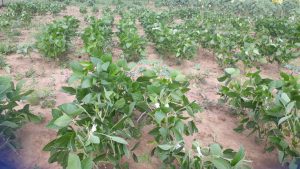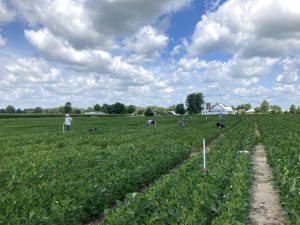Click Here if you listened. We’re trying to gauge interest so only one question is required; however, there is a spot for feedback!
Read along below!
Found in Translation
Bees have an increasing say in soybeans
By: Jay Evans, USDA Beltsville Bee Lab
Farmers and scientists debate the extent to which one of our country’s favored crops, the soybean, benefits from honey bee visits. Nor are they sure that having bees visit soybean crops is a net positive for the bees. Despite research documenting strong benefits to soybeans from honey bee visits (dating since the youth of former Bee Culture editor Kim Flottum, https://www.beeculture.com/found-in-translation-19/), a perusal of thousands of studies related to soybean farming shows little emphasis on how and when bees should be deployed. As one metric, a March 2023, Google Scholar search of papers mentioning “soybean yield” and “honey bee” provided 276 references. The same search excluding the term “honey bee” provided 62,200 references. This overall trend has not improved in recent years; papers mentioning soybean yields that do not mention honey bees number 5,110 since 2022, while only 32 papers mention honey bees. Fortunately, those 32 papers provide some really important advances. The upshot is that bees can greatly improve soy production, while potentially gathering a resource for themselves and their keepers. What remains to work out:
- How can beekeepers practice safe soy?
- How can growers choose varieties and management practices that harness bee visits to boost production of a vital row crop?
- How can the two sides meet up to work out deals that benefit both industries and the environment?
 On the soy side, honey bee pollination impacts were described this month in a freely available paper from Decio Gazzoni and João Paz Barateiro (Gazzoni, D.L. & João Vitor Ganem Rillo Paz Barateiro. 2023. Soybean yield is increased through complementary pollination by honey bees, Journal of Apicultural Research, DOI:
On the soy side, honey bee pollination impacts were described this month in a freely available paper from Decio Gazzoni and João Paz Barateiro (Gazzoni, D.L. & João Vitor Ganem Rillo Paz Barateiro. 2023. Soybean yield is increased through complementary pollination by honey bees, Journal of Apicultural Research, DOI:
10.1080/00218839.2022.2161219). These authors showed that, with the right conditions and soybean varieties, honey bees increased soybean yields in controlled environments by 8.5-18.2% in four trials across three years. This increase is not as dramatic as other studies from different cultivars, but still reflects a lot of beans. Hannah Levenson and colleagues at North Carolina State University also showed recently that supporting bees merely by expanding local non-crop habitat led to a significant difference in soybean seed (bean) weights. In an exhaustive survey of 7,000 bees in the field, they found that 30+ bee species had collected soybean pollen but honey bees tended to be more faithful than others for soy versus alternatives (Levenson, H. K., A. E. Sharp, and D. R. Tarpy. 2022. Evaluating the impact of increased pollinator habitat on bee visitation and yield metrics in soybean crops. Agriculture, Ecosystems & Environment 331:107901, https://www.sciencedirect.com/science/article/abs/pii/S0167880922000500).
If bees are generally good for soybeans, are these visits doing bees any good? Chia-Hua Lin and colleagues at The Ohio State University have been on that story for some time and recently published a complex study asking whether bees 1) make it to abundant local soybean fields and 2) bring home resources for their colonies (Lin, C.-H., Suresh, S., Matcham, E., Monagan, P., Curtis, H., Richardson, R. T., & Johnson, R. M. 2022. Soybean is a Common Nectar Source for Honey Bees (Hymenoptera: Apidae) in a Midwestern Agricultural Landscape. Journal of Economic Entomology, 115(6), 1846-1851. doi:10.1093/jee/toac140). In a citizen-science twist, the scientists asked members of the Ohio State Beekeepers Association to bring honey collected by bee colonies from across the state to their Fall meeting. This honey was screened for the presence of different pollen types under microscopy. As indicated by the title, soybean pollen was commonly found in Ohio honeys. More than half of the screened honeys held soybean pollen, and this increased for honey derived from foraging in July and August, when soybean flowers were most common. Finally, the authors used the waggle dance, the signal bees use within their colonies to direct nestmates to good foods, to show that returning bees are eager to tell their nestmates about soybean rewards. For medium-distance flights, returning bees were more likely to ‘dance’ that they had visited soybean fields than other fields, complementing the pollen collection data and saying that bees preferentially target soybean fields over the alternatives. Dr. Lin has backed up this work with some truly remarkable studies covering the attractiveness of dozens of soybean cultivars to bees in common gardens (e.g., https://ohiocroptest.cfaes.osu.edu/soy2022/2022_OSPT_pollinator_report.pdf) and is working relentlessly to improve cross-pollination between beekeepers and soybean growers.

Team B & B (Bees and Beans) collecting flowers in soybean plots last Summer. The white stakes are Karlan Forrester’s audio recorders. Photo provided by Chia-Hua Lin from the Rothenbuhler Honey Bee Lab at The Ohio State University
In ongoing work, graduate student Karlan Forrester (working with Chia-Hua Lin and Reed Johnson at Ohio State), has worked out innovative methods for tracking bees as they zero in on soybean flowers, while also confirming that certain soybean varieties are more rewarding, and hence attractive, to discerning bees (Forrester, K. C., Lin, C.-H., & Johnson, R. M. 2022. Measuring factors affecting honey bee attraction to soybeans using bioacoustics monitoring. BioRxiv, 2022.2011.2004.512777. doi:10.1101/2022.11.04.512777).
In looking for soy-bee stories that describe ways to enhance this partnership, I came across a series of fascinating works from the other side of the world. Dr. Dolapo Bola Adelabu, a researcher from the Free State of South Africa, and his colleague Angelinus Franke, found remarkable increases in soybean yields that can be attributed to visits by bees and other pollinators (Adelabu, D.B., Franke, A.C. 2023. Beneficial Role of Pollination and Soil Fertility for Soybean Production in Mountainous Farming Conditions. In: Membretti, A., Taylor, S.J., Delves, J.L. (eds) Sustainable Futures in Southern Africa’s Mountains. Sustainable Development Goals Series. Springer, Cham. https://doi.org/10.1007/978-3-031-15773-8_5). These yields were greater than 50% when combined with optimal fertilizer supplementation of crops (Nitrogen and Phosphorous), with less striking increases under poor soils. Farming in this region of southern Africa, in a rugged corner of the Free State, is distinguished by “smallholder” farms, where farms are interspersed with homes and natural areas. This farming scheme allows for both wild bee habitat (honey bees are not routinely kept in hives here) and presumably a range of alternate food sources for bees when soybeans are not in flower. In conversing with Dr. Adelabu, the studies did not distinguish Apis mellifera from other bee species, but it seems likely that honey bees were a major member of the pollinating community. Thanks to this research, the services bees provide in terms of local soybean yields, among other crops, justifies the work needed to keep healthy bee habitat. The two scientists in this work are also more broadly interested in schemes to provide healthy nutrition to a fairly dense human population, while maintaining a sustainable environment, ( e.g., https://www.ufs.ac.za/aru/aru-team/aru-team/prof-angelinus-franke). Hannah Levenson phrases it well in her article, “As such, pollinator habitat should be designed to provide resources across the entire active season to help these important pollinator populations, especially since many crops have short bloom durations.”
One hope from all this research for the U.S. will be improved dialogue between beekeepers and soybean farmers, ideally driven by profits on both sides. This dialogue will help bees collect soy flower resources while minimizing collateral damage from agricultural practices, including the need to treat for crop diseases and insect pests. In the meantime, what are the best practices for beekeepers around soybean farms? The Honey Bee Health Coalition has focused on this issue, leading to a draft of guidelines led by Adam Dolezal at the University of Illinois showing how management practices, from pesticide applications to habitat, can be more bee-friendly (https://honeybeehealthcoalition.org/resources/soybean-best-management-practices/). Making more food on fewer acres is good for the planet and the economy, and it is great that scientists and farmers on both sides are tackling the soy-bee system in a rigorous way.







